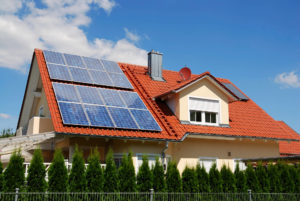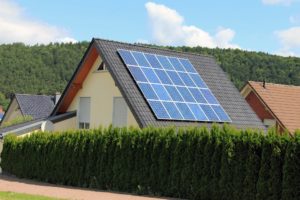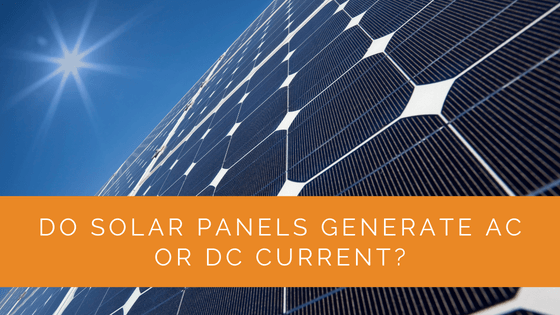In the ever-evolving world of solar energy, one fundamental question often arises: Do solar panels generate AC or DC? Understanding the answer to this question is crucial for effectively harnessing the sun’s power. In this article, we’ll delve into the basics of AC and DC electricity, explore how solar panels produce DC power, and uncover the role of solar inverters in converting it into the AC voltage that powers our homes. Additionally, we’ll touch upon the intriguing concept of AC solar panels and their potential advantages. As the solar industry continues to innovate, we’ll navigate the evolving landscape of DC and AC systems and their implications for a brighter, more eco-friendly future. So, let’s shed some light on the electrifying world of solar energy.
Contents
- 1 Key Takeaways
- 2 AC and DC – Basics
- 3 What Electric Charge Do Solar Panels Generate?
- 4 How Do Inverters Convert DC into AC?
- 5 What are AC Solar Panels?
- 6 Do Solar Panels generate DC Power Still Beneficial?
- 7 Expert Insights From Our Solar Panel Installers About Do Solar Panels Generate AC or DC Current?
- 8 Experience Solar Excellence with Us!
- 9 Wrapping Up
Key Takeaways
- Solar panels generate direct current (DC) electricity when exposed to sunlight, as electrons flow in one direction within the panels.
- To power household appliances, solar inverters are used to convert DC into alternating current (AC), which is compatible with most devices and the electric grid.
- AC solar panels, equipped with microinverters, simplify installation and improve individual panel performance monitoring, but they are typically more expensive than traditional DC solar panel setups.
AC and DC – Basics
The late 1870s and early 1880s witnessed a science battle, popularly termed the “War of Currents.” Thomas Edison and Nikola Tesla were embroiled in AC or DC propagation.
Edison introduced the world to DC (Direct Current). It runs in a single direction and was initially hailed as the standard form of electricity in the US. If you visualize the flow of DC, you will observe a straight-line graph.
However, multiple shortcomings were faced while using DC on a large scale. First, the current didn’t conveniently convert into a low or high voltage value. Additionally, transporting it across a long distance resulted in huge electricity losses.
To overcome such drawbacks, Tesla introduced Alternating Current (AC). It is a form of electricity where electrons run back and forth in both directions. If you visualize the graph, it looks like a sinusoidal wave or a vibration.
What Electric Charge Do Solar Panels Generate?
Solar panels consist of photovoltaic cells. Here, when the sun rays fall on the panel surface, some electrons are knocked loose from the atoms of the semiconductor surface, like silicon. As these electrons flow in the same direction, the solar energy generated is DC.
However, this resulting power is unregulated and cannot be used to operate any appliances directly. Therefore, you require some electric circuits to make it properly usable. That’s where solar inverters come in.
Solar or PV inverters help convert the DC generated from the solar panel to AC voltage. The electric grid accepts the resulting AC charge and can be further utilized to use electric motors, refrigerators, televisions, or other home appliances.

How Do Inverters Convert DC into AC?
Inverters first originated in the 19th century and worked on mechanical phenomena. However, things have significantly changed in the past two centuries. Initially, inverters converted DC to AC power by quickly switching the output current’s polarity from positive to negative.
The resulting motion resembles a square wave and gives an increased voltage value with the decreased current. However, there is a significant disadvantage to this process. The square waves are often abrupt and can end up causing substantial harm to electric appliances in your household.
Manufacturers have started working with rectification devices that produce modified sine waves (MSW) to overcome this issue. They are gentler for a household system and less likely to cause irreversible damage.
Therefore, when multiple solar panels are installed on a rooftop in a fixed pattern, output power lines are connected to the DC input for the inverter. Usually, the DC voltage range for smaller installations does not cross 1,000 volts. However, the DC power value can be as much as 1,500 volts for large-scale industrial installations.
What are AC Solar Panels?
On hearing the term AC solar panel, one might assume that such devices can generate AC power directly. But that’s not the entire truth.
The basic process of electricity generation remains the same in this solar system. However, instead of connecting all panels in a line and attaching an inverter, each panel here comes with a microinverter.
AC solar panels are more expensive than their conventional counterparts. Nonetheless, the increased price brings along some essential benefits:
- The installation process gets much smoother and requires less time as there is no need to establish a central inverter connection.
- In a conventional setting, the inverter works like an Achilles heel. It prevents other panels from performing at their maximum capacity if one device is faulty.
- With AC solar modules, you can install panels anywhere without worrying about the design orientation and distance from the inverter.
- You can easily track the performance of each panel and how much power it generates.

Do Solar Panels generate DC Power Still Beneficial?
Even though most appliances use AC, new power supplies in the market rapidly propagate the usage of DC power. Some standard DC applications you must know are renewable energies, electric vehicles, power electronics, HVDC transmission systems, etc.
DC conversion to AC can result in high electricity costs and is often more expensive. Therefore, new technological inventions are focused on making the household load compatible with direct current flow.
Expert Insights From Our Solar Panel Installers About Do Solar Panels Generate AC or DC Current?
Solar panels naturally generate DC current, which is essential for storing energy in batteries. However, to power household appliances, this DC current needs to be converted to AC using an inverter.
Senior Solar Installer
The role of inverters in a solar panel system is crucial. They convert the DC power produced by solar panels into AC power, which is compatible with our home appliances and the grid.
Lead Solar Technician
Understanding the difference between AC and DC power is key for anyone looking to invest in solar energy. While solar panels produce DC electricity, the integration of efficient inverters allows for seamless use of AC power in our daily lives.
Chief Installation Engineer
Experience Solar Excellence with Us!
Trust in Solar Panels Network USA, where our seasoned experts deliver top-quality solar solutions for homes and businesses nationwide. With a legacy of countless successful installations and a commitment to sustainable energy, we’re your reliable partner in the solar journey. Ready for a brighter, eco-friendly future? Call us now at (855) 427-0058 and harness the sun’s power!
Wrapping Up
The solar field is rapidly progressing, offering the world a chance to utilize a non-exhaustive energy source for daily electricity requirements. Instead of a power plant, consumers can set up photovoltaic panels on their roofs and harness the current generated by sun radiations.
However, this resulting electricity is a direct current where the electrons only flow in a single direction. Most household appliances are not compatible with DC. Therefore, power supplies like a solar inverter must be installed to convert DC into AC.
The energy stored in the battery is in the form of DC. When needed, the charge passes through the inverter and reaches the electric devices in the form of AC. Simultaneously, multiple changes are happening in the solar field, propagating the usage of hybrid DC and AC systems.
About the Author
Solar Panels Network USA stands at the forefront of solar energy solutions, driven by a team of seasoned solar engineers and energy consultants. With over decades of experience in delivering high-quality solar installations and maintenance, we are committed to promoting sustainable energy through customer-centric, tailored solutions. Our articles reflect this commitment, crafted collaboratively by experts to provide accurate, up-to-date insights into solar technology, ensuring our readers are well-informed and empowered in their solar energy decisions.

